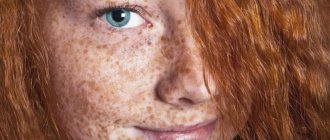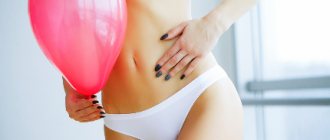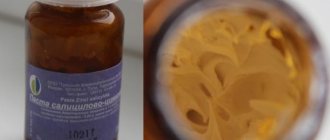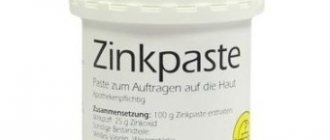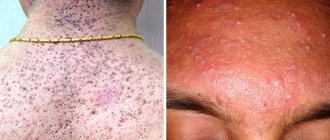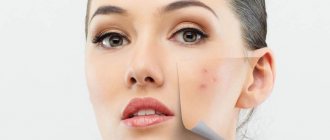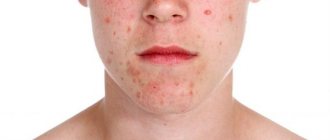Acne and its common consequence, post-acne, are a fairly acute and common dermatological problem. The term “acne” refers to acne or inflammation of the sebaceous glands and hair follicles, which is accompanied by the formation of numerous pimples of different sizes and types. Most often, this disease occurs in adolescents, lasts for years and is difficult to treat. Although it can also develop in adulthood, including after 30-35 years.
According to the latest data, more or less 85% of people suffer from acne, and in 15-30% of cases the disease is severe and requires complex, long-term complex treatment. Acne affects those areas of the skin where sebaceous glands are most concentrated. Therefore, very often it affects the face, which causes serious psychological complexes. But acne can also occur on other parts of the body, in particular the back. At the same time, one of the common complications of the disease is post-acne, i.e. persistent changes in the skin in the form of spots, and more often scars of different sizes, which are extremely difficult to deal with, but still possible.
What kinds of post-acne acne occur?
There are 3 types of post-acne, not only age spots:
- Scars are the most undesirable complication of post-acne
- Pigment spots – brown spots on the sites of former rashes
- Congestive erythema - redness accompanied by compaction from an unresolved element
All three types of post-acne can be present on the skin either simultaneously or separately, depending on individual characteristics and the tendency to develop pigmentation or scars.
How to deal with post-acne spots on your face at home
There are several ways to get rid of acne at home. One of them is associated with the use of special care products. We are talking about acid formulas:
- AHA acids (fruit) - gently remove the old layer of the epidermis, making the skin smoother and spots lighter;
- BHA acids (salicylic) - in this case, the exfoliating effect is combined with cleansing the pores;
- Peels with lactic acid work like products with fruit acids.
Also, don’t forget about soft scrubs and moisturizer after all these manipulations.
Important: it is better not to use acids if there are wounds or other mechanical damage on the face.
And one more thing - do not buy professional products that cosmetologists use. They are already dangerous, and in the wrong hands they can cause severe burns. Buy products that you can use at home.
The main predisposing factors for the appearance of post-acne
- Severity of acne – acne of III and IV severity often leads to complications, because affect the deep layers of the skin.
- Individual skin characteristics, genetic predisposition - such as dark skin color, a tendency to increase melanin production at the slightest inflammation or damage to the skin.
- Lack of treatment, inappropriate treatment, or late treatment is when the process has been present in the skin for a long time and has affected deep tissues.
- Skin injuries during mechanical cleaning, i.e. when roughly squeezing out pimples.
The presence of at least one predisposing factor may be the cause of the development of post-acne.
Diagnostics
If signs of acne occur, you should consult a dermatologist or dermatocosmetologist. The doctor will not only evaluate the number of elements, their nature, location and the presence of signs of post-acne, but will also clarify the patient’s dietary habits, whether close relatives have suffered from similar acne on the face, and a number of other points. In general, acne can be diagnosed and its severity determined at the first consultation, since the disease has a specific clinical picture.
But in order to choose the optimal treatment tactics, you need to accurately determine the cause of acne development and assess the general condition of the body. For these purposes, patients are prescribed:
- UAC;
- OAM;
- blood chemistry.
Identifying the cause of acne is extremely important, as it is a chronic disease. Therefore, in the absence of control, it can recur at any time when favorable conditions are created.
When diagnosing post-acne, the nature of facial skin changes, the presence of scars, their shape, depth, localization, and ability to smooth out when the skin is stretched are also assessed.
How to avoid age spots and scars
- Start acne treatment immediately. Even mild forms cannot be ignored - grade 0-2 acne, when there are single elements on the skin.
- Don't push! A banal but difficult point to implement. Skin cleansing can be done and sometimes even necessary, but it should be done carefully and competently by a cosmetologist.
- Use medications with anti-inflammatory effects. Not to be confused with antibacterial! Anti-inflammatory drugs have both preventive and therapeutic effects.
Recommendations follow from the previous paragraph - exclusion of predisposing factors.
Is it possible to quickly remove acne spots (vacuum)
Vacuum massage is another great home remedy for acne spots. You can buy massage jars on the website www.beauty365. And don't forget about plant squalane. It is made from sugar cane and is ideal for vacuum massage.
Glass jars will help get rid of other problems:
- Edema;
- Wrinkles;
- Hyperpigmentation;
- Gray face.
Regular massage will help restore skin tone, make it elastic and beautiful.
The main thing is not to confuse the jars - there are those that can be used on the face and décolleté, while others are intended for working on the body and limbs. They vary in size and degree of impact. But we recommend purchasing both the first and the second. Because when working with the body, you can get rid of extra centimeters on the sides, stretch marks and cellulite.
Vacuum massage is, of course, an excellent remedy for many ailments. But there are other cool techniques that you can do yourself. To get rid of jowls, wrinkles and even blue under the eyes, get acquainted with the advanced intensives from Annette. This is a concentration of the best author's exercises in one place. This is the result of 2 weeks of active practice. Try it yourself and show it to your friends.
How to get rid of post-acne
Recommendations of the International Society of Dermatologists and Cosmetologists: 1st line drugs for acne and post-acne treatment are retinoids .
- Have an anti-inflammatory effect;
- Normalize the functioning of pigment cells, lighten pigment spots;
- Normalizes the functioning of the sebaceous glands. With acne, the amount and composition of sebum changes - the main reason for the development of acne;
- Increase local immunity, which helps fight inflammation;
- Stimulate the synthesis of collagen necessary to fight scars.
Due to such a wide range of cosmetic effects on the skin, retinoids are recognized as the gold standard for the treatment of acne and post-acne.
The result of using retinoids:
- lightening pigment spots
- smoothing skin texture
- reduction of scar depth
Retinol benefits:
- Physiological – is a substance familiar to the skin, because the body itself supplies vitamin A to the skin in low concentrations;
- Has no toxic effect;
- Suppresses the increased activity of melanocytes, without destroying them, but normalizes melanin production;
- Penetrates well into the skin, reaching the necessary layers;
- Stimulates cellular renewal, preventing colored cells from remaining on the surface, and accelerates their exfoliation.
Post-acne - symptoms and treatment
How to get rid of acne spots
According to Dr. A.S. Pirmanova, in order to prevent the transformation of a stagnant post-acne spot into a scar, it is important to properly monitor it for three months:
- do not expose the stain to physical, chemical and mechanical stress and, as a result, damage;
- avoid excessive solar insolation;
- moisturize the skin well - a cosmetic cream with hyaluronic acid or a pharmaceutical product with zinc hyaluronate (Curiosin, Regetsin and others) is suitable for this purpose.
Pharmacy ichthyol 20% ointment is perfect as a non-hormonal anti-inflammatory agent. Within two weeks, the stagnant spot will turn from red to pale pink.
If the skin has a tendency to hypertrophic scars, then an external product with silicone is suitable - silicone dioxide or polysiloxane. It can be applied in the early period of post-acne scar formation. It forms a silicone film that reduces fibroblast activity and collagen production.
How to remove acne scars
There are surgical and non-surgical methods for correcting acne scars.
Surgical procedures include scar excision and laser destruction (destruction). These methods are mainly used for keloid and large hypertrophic scars. They are accompanied by subsequent intralesional administration of prolonged steroids in the form of suspensions (in the case of keloids) and enzyme therapy (injections with longidase and collagenase).
All non-surgical methods for correcting post-acne scar tissue can be divided into:
- pharmacological;
- hardware;
- injection;
- combined.
Pharmacological therapy
This treatment method includes chemical peels:
- superficial - salicylic, pyruvate, glycolic, milk peels and others;
- median - TCA (trichloroacetic) peeling 15-30%, Jessner peeling;
- deep - phenol peels (used before, but now due to the large number of complications they are not carried out).
Each of these types of peeling has its own indications, contraindications, and application features.[20] This method alone, without other correction options, can only be effective in the treatment of stagnant post-acne spots and shallow square-shaped scars.
Hardware treatment methods
Such post-acne treatment methods include dermabrasion, microdermabrasion and laser resurfacing.
Classical dermabrasion - exfoliation of the top layer of skin using abrasive cutters (special tips) - is an outdated technique due to the pain during the procedure, which often required general anesthesia.
Microdermabrasion - painless micro-resurfacing of the skin - is effective in correcting stagnant post-acne spots and shallow square scars, the depth of which is no more than 0.5 mm.
Laser resurfacing is a very effective way to combat post-acne. Round and square atrophic scars respond well to correction using CO2 laser resurfacing (by the way, the first CO2 laser resurfacing was used back in 1985 for the treatment of actinic cheilitis[21]) or erbium laser.[22] But this is only possible if the doctor correctly assessed the shape and depth of the scar and accurately selected the parameters.
Injection treatments
Needling is multiple microperforations of the skin using a special sterile roller with needles no more than 2 mm long. This procedure corrects and improves the appearance of stagnant post-acne spots and superficial atrophic scars. The effectiveness of needling when used in isolation is 10-30%, which is comparable to the result of plasma lifting or mesotherapy.
Plasmolifting is an injection of platelet plasma into the deep layers of the dermis.[23] As practice shows, without combination with other methods of aesthetic correction, this therapy is ineffective.
Mesotherapy is carried out on the principle of plasma lifting, only in this case microinjections of vitamins, enzymes, nucleic acids and amino acids are introduced. However, good results can be achieved with complex treatment of post-acne scars.[24]
Another method of treating post-acne is filling the scar with preparations based on hyaluronic acid or collagen.
How to quickly remove post-acne
As experience in treating post-acne manifestations shows, there are three rules for successful therapy :
- Do not rush, as after each procedure the patient’s skin needs time to fully recover. A hasty pace of treatment is usually fraught with complications.[27]
- Combining techniques - only complex treatment of patients with scars allows achieving optimal clinical results.[25]
- Proceed with the correction of deep scars only after preliminary subcision - delimitation of the scar from the underlying structures to which it is fused. Since deep acne scars are usually very tightly fused to the underlying tissues, without this procedure, other aesthetic correction will be ineffective. Subcision can create a void, which can then be filled with, for example, collagen fillers.[26]
How to remove acne due to enlarged pores
Enlarged pores are one of the signs of oily skin; narrowing them will not work. When sebum does not reach the surface well, the pores expand, inflammation occurs, and acne develops. Therefore, if you have enlarged pores, it is important to take care of your skin. If post-acne has already developed, then it can only be removed with the help of polishing, laser and other types of ablations.
How to get rid of persistent erythema due to post-acne
It is important to distinguish between post-acne and rosacea. If the redness is caused by erythema against the background of post-acne spots, then the skin may still be inflamed. In this case, you need to treat the underlying disease - acne, and only then get rid of post-acne scars. If you have rosacea against the background of post-acne spots, you need to treat the underlying disease - rosacea. Often erythema and sensitivity of the skin due to post-acne develop after the use of systemic retinoids, so before taking them you should definitely consult your doctor.
How to get rid of acne scars at home
To remove post-acne scars, you need to destroy the old tissue down to the papillary dermis layer. It is impossible to do this safely at home.
Only the subcision method can effectively remove acne scars on the face.
Maxim Vasiliev’s method against acne scars is based on the subcision method - a special microtechnique for cutting scars. This method was first used in 1995 and works great even against the most old and deep atrophic scars.
Subcision is a painstaking method of correcting atrophic post-acne scars.
Subcision is performed under local anesthesia using a powerful microscope. Using a sterile syringe needle, the surgeon carefully and quickly cuts the so-called “strands” - separating the scar tissue from neighboring structures. The skin, which is no longer held in place, rises and straightens.
Photos "before" and "after"
Subcision is the most effective way to treat acne scars. The result “before” and “after” of one procedure. Surgeon: Vasiliev Maxim.
Correction of deep scars. Photos "before" and "after". Completed by: Vasiliev Maxim.
Laser resurfacing of post-acne scars. Performed by dermatocosmetologist Elena Vlasova.
Ways to quickly remove or disguise post-acne
Very often post-acne disappears on its own. Special care and patient waiting help with this. Typically, the skin restoration cycle is 28 days. So these days you don’t have to resort to additional measures, just use the right skincare products.
And cosmetics will help brighten up the wait. But you also need to be able to use it in such a way that it does no harm, but at the same time hides everything you need:
- First of all, you need to prepare your skin for applying makeup. Cleanse it with lavender hydrosol and apply a thin layer of sunscreen. It would be great if it was also moisturizing. This is available in the store www.beauty365;
- After the product is absorbed, you can apply mattifying cream. It will make the skin smoother;
- Use a green concealer to cover all acne-prone areas. Blend thoroughly and let dry for 1-2 minutes;
- If you wish, you can also apply foundation. But it is better not to use it very often, as it does not allow the skin to breathe and clogs the pores;
- Powder will help fix the result.
Microdermabrasion (mechanical peeling)
This hardware method is one of the methods for resurfacing skin with post-acne scars, although today it is much less popular than, for example, laser dermabrasion (resurfacing), since it affects only the superficial layers of the skin.
In the process of microcrystalline dermabrasion, a device nozzle is placed on an area of \u200b\u200bthe skin with an area of \u200b\u200b1 cm2, in which there is a chamber with two holes: from one, a stream of air containing microcrystals (for example, aluminum oxide/corundum) is supplied under pressure, and in the other a vacuum is created. As a result, microcrystals hit the surface of the skin at high speed and mechanically remove epidermal cells, while the mixture of crystals and removed cells is sucked into a special container by vacuum. The impact affects only the superficial layers of the skin; during the procedure, complete or partial removal of the epidermis occurs, followed by its regeneration. The depth of impact depends on the rate of release of microcrystals, which is determined by the speed of movement of the tip, the number of passes over the same area, and the patient’s skin type.
To achieve the effect, a series of procedures (from 2 to 12) is usually carried out once a week. The more pronounced the skin defect, the more sessions are required.

